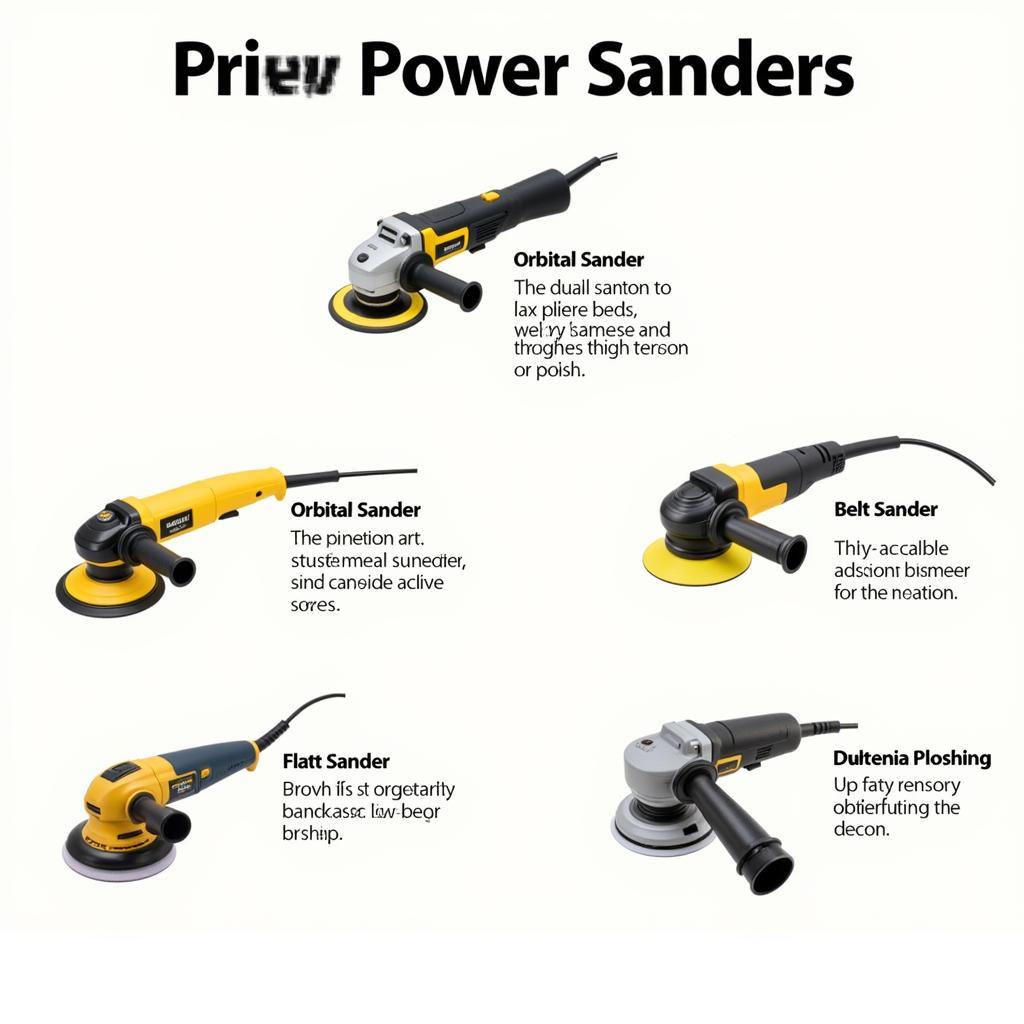Sanding a car is a crucial step in achieving a flawless paint job. Whether you’re a seasoned professional or a DIY enthusiast tackling a weekend project, having the right sanding tools can make all the difference. This article will guide you through the essential tools needed for sanding a car, helping you achieve professional-quality results.
Essential Sanding Tools for a Perfect Car Finish
From prepping the surface for primer to achieving that glass-smooth finish, each stage of car sanding requires specific tools. Selecting the right tools will not only save you time and effort but also ensure a superior outcome. Let’s dive into the must-have sanding tools for any car project.
Sandpaper: The Foundation of Sanding
Sandpaper is arguably the most crucial tool in your sanding arsenal. Available in various grits, from coarse to ultra-fine, choosing the correct grit is essential for each stage of the sanding process. Start with coarser grits for removing imperfections and gradually move to finer grits for smoothing and polishing. Remember, using the wrong grit can lead to scratches or an uneven surface. Always opt for high-quality sandpaper designed for automotive use.
Sanding Blocks: Ensuring Even Pressure
While you can sand by hand, using a sanding block is highly recommended. Sanding blocks provide even pressure distribution, preventing uneven sanding and potential damage to the car’s surface. They come in various shapes and sizes, allowing you to tackle different contours and curves effectively. Choose a sanding block that comfortably fits your hand and suits the specific area you’re sanding.
Power Sanders: Efficiency and Speed
For larger areas or more extensive sanding jobs, power sanders are invaluable. From orbital sanders to dual-action sanders, these tools significantly speed up the sanding process while maintaining consistent results. Orbital sanders are great for flat surfaces, while dual-action sanders offer more versatility, allowing you to both sand and polish.
 Different Types of Power Sanders for Car Sanding
Different Types of Power Sanders for Car Sanding
Sanding Discs: The Right Fit for Your Sander
Power sanders require sanding discs, which come in various grits and materials. Match the grit of the sanding disc to the stage of your sanding process, just like with sandpaper sheets. Ensure the discs are compatible with your specific sander model for optimal performance.
Safety Gear: Protecting Yourself During Sanding
Sanding creates dust and debris, so protecting yourself is paramount. Always wear safety glasses to shield your eyes from flying particles. A dust mask is crucial to prevent inhaling harmful dust, especially when working with older paint that may contain lead. Gloves protect your hands from abrasion and ensure a better grip.
“Safety is paramount when sanding a car,” advises John Smith, a veteran auto body technician at Smith’s Auto Repair. “Never compromise on safety gear, even for small sanding tasks.”
Other Helpful Tools
While the above tools are essential, a few other items can make the sanding process smoother:
- Tack Cloth: Used to remove dust and debris between sanding stages.
- Masking Tape: Protects areas you don’t want to sand.
- Compressed Air: Useful for blowing off dust and debris.
- Panel Wipe: Cleans the surface before and after sanding.
 Essential Car Sanding Safety Gear
Essential Car Sanding Safety Gear
“Using a tack cloth between sanding stages ensures a cleaner surface for the next grit,” adds Maria Garcia, a seasoned automotive painter at Garcia’s Custom Paint. “This helps achieve a truly flawless finish.”
Conclusion
Having the right tools is essential for achieving a professional-quality car sanding job. By investing in quality sanding tools and following proper safety precautions, you can achieve that perfect, smooth surface ready for priming and painting. Remember to select the appropriate grits for each stage of the sanding process and utilize the right tools for the job, whether it’s a simple touch-up or a full-body restoration. With the right tools and knowledge, What Tools Needed For Sanding A Car becomes a question easily answered.
FAQ
- What grit sandpaper should I start with for car sanding? Start with a coarser grit, such as 180-grit, for initial sanding and gradually move to finer grits.
- What is the purpose of a sanding block? A sanding block ensures even pressure distribution, preventing uneven sanding and potential damage to the car’s surface.
- What type of power sander is best for car sanding? Orbital and dual-action sanders are commonly used for car sanding, with dual-action sanders offering more versatility.
- Why is safety gear important when sanding a car? Sanding creates dust and debris that can be harmful to your eyes and lungs. Safety gear protects you from these hazards.
- What is a tack cloth used for? A tack cloth is used to remove dust and debris between sanding stages, ensuring a clean surface for the next grit.
- How do I choose the right sanding disc for my power sander? Ensure the sanding disc is compatible with your sander model and select the appropriate grit for the stage of your sanding process.
- What is panel wipe used for in car sanding? Panel wipe is used to clean the surface before and after sanding, removing any contaminants that could interfere with the paint adhesion.
Need further assistance? Contact us via WhatsApp: +1(641)206-8880, Email: [email protected], or visit us at 910 Cedar Lane, Chicago, IL 60605, USA. Our customer service team is available 24/7.

Leave a Reply